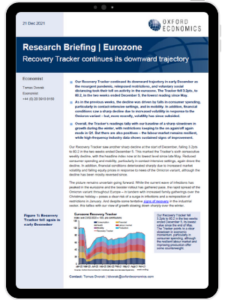Eurozone Recovery Tracker continues its downward trajectory

Our Recovery Tracker continued its downward trajectory in early December as the resurgent pandemic, reimposed restrictions, and voluntary social distancing took their toll on activity in the eurozone. The Tracker fell 3.2pts, to 80.2, in the two weeks ended December 5, the lowest reading since May.
As in the previous weeks, the decline was driven by falls in consumer spending, particularly in contact-intensive settings, and in mobility.
What you will learn:
- Financial conditions saw a sharp decline due to increased volatility in response to the Omicron variant – but, more recently, volatility has since subsided.
- Overall, the Tracker’s readings tally with our baseline of a sharp slowdown in growth during the winter, with restrictions keeping to the on again/off again mode in Q1.
- But there are also positives – the labour market remains resilient, while high-frequency industry data shows sustained signs of improvement.
Tags:
Related research

Post
House prices continue to slide for China’s cities
Research Briefing Eurozone Recovery Tracker continues its downward trajectory While the property market downturn has been universal, the scale and depth has been varied for different cities and regions.
Find Out More
Post
The Construction Productivity Challenge in Australia
Delve into the state of construction productivity in Australia. Understand the factors affecting growth and how innovation can transform the industry for the better.
Find Out More